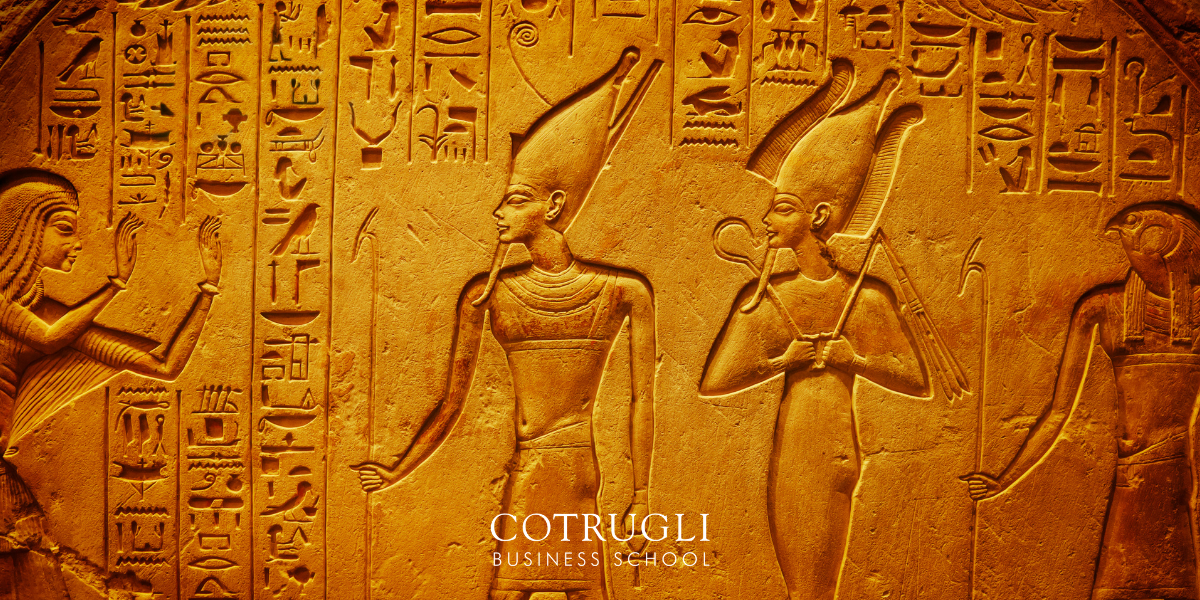
Stillness and the Sound of Silence
31/07/2023
Digital Transformation: Unlocking Outstanding Performance and Long-Term Growth
01/08/2023
Agriculture: Foundation of Wealth
Agriculture formed the backbone of Ancient Egypt’s economy. The annual flooding of the Nile was the most significant event, as it determined whether harvests would be rich or poor. The Nile also served as a vital transportation and communication route, connecting regions and supporting the economic system.
Geographic Advantage and Longevity
Located along the Nile and shielded by vast deserts, Egypt thrived in stability and prosperity for nearly three millennia—from its unification around 3100 BC until the Roman conquest in 31 BC.
A Command Economy
Ancient Egypt operated under a theocratic monarchy, where the Pharaoh, seen as divine, owned everything—land, people, and resources. The economy followed a command or palace model, with Pharaohs and their loyal bureaucrats—scribes, nobles, and priests—controlling key sectors like agriculture, mining, luxury goods production, and foreign trade.
Taxes and Public Works
Taxes were the Pharaoh’s main revenue source. Farmers paid taxes in grain, typically 10–20% of the annual harvest, and in labor, contributing to state projects and the military. In times of drought or poor harvests, rulers often forgave taxes to help citizens recover. This practice, called “philanthropa,” inspired the modern term philanthropy.
Public vs. Private Sector
As the primary investor in international trade and major enterprises, the Pharaoh left little room for private entrepreneurship. Unlike in other civilizations, private businesses and financial innovations were limited, and the merchant class remained underdeveloped.
Women in Business and Labor Rights
Women in Ancient Egypt enjoyed exceptional legal and social rights. Their status depended on rank, not gender, and they had the right to own property, sign contracts, and run businesses. Most notably, they were paid equally for the same work—a level of gender equality still not achieved in many societies today.
Egypt also recorded the first labor strike in history, held in Deir el-Medina during the reign of Ramses III (12th century BC). Workers demanded better conditions—and won.
Trade and Colonies
Egyptians saw their civilization as superior and interacted with foreign cultures—like Mesopotamia, Lebanon, Greece, and Punt—mainly through trade. They also established colonies in Nubia, Syria, and Palestine to support mining and trade operations, as well as extend their political influence.
Major exports included grain, gold, and high-quality goods like papyrus, pottery, linen, and luxuries crafted in state or temple workshops. In return, they imported wood, metals (silver, copper), oils, and rare items such as ivory, glass, spices, animal skins, and lapis lazuli.
Signature Exports
Papyrus, the namesake of the word “paper,” became a major export and the most widely used writing material across the ancient world. Perfumes, expertly crafted by Egyptian artisans, were another highly valued export.
Trade Without Coin
Despite Egypt’s wealth, metal coins weren’t introduced until around 500 BC. For most of its history, Egypt relied on barter. To standardize trade, they used the “deben”, a unit of weight equal to 91 grams, to measure and compare the value of goods.
The salaries in ancient Egypt were calculated in units of bread and beer, the two basic staples in Egyptian diet. The standard basic wage was ten loaves of bread plus one-third to two full jugs of beer per day. This was the amount paid to the lowest-paid staff members.




